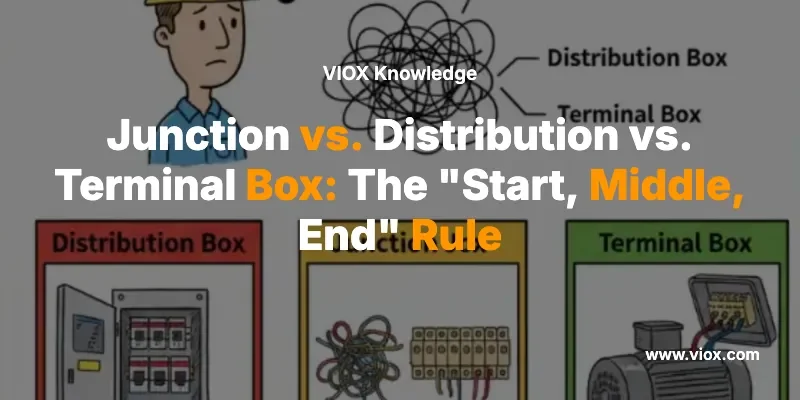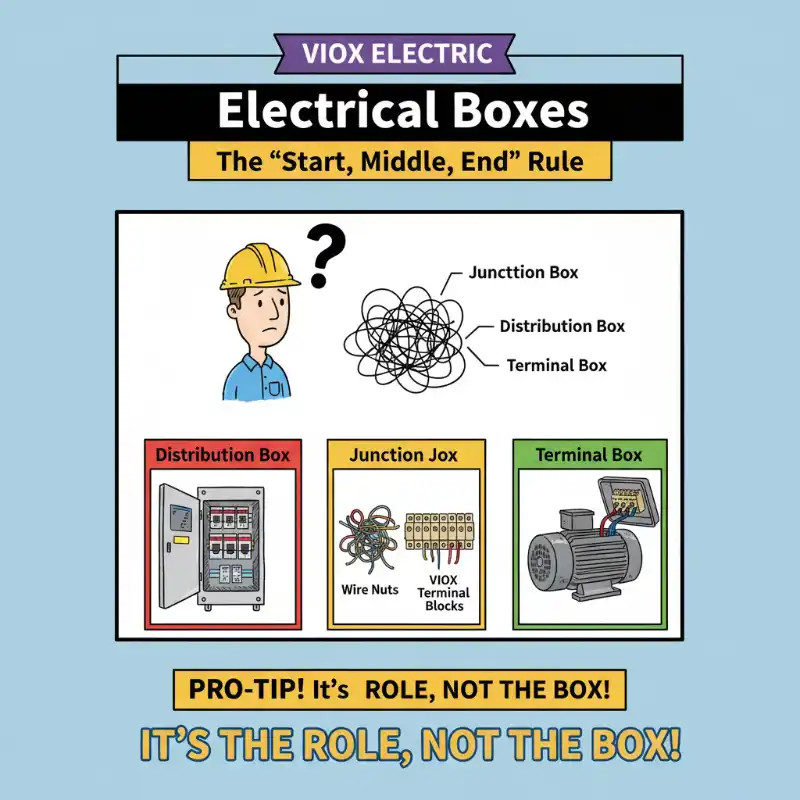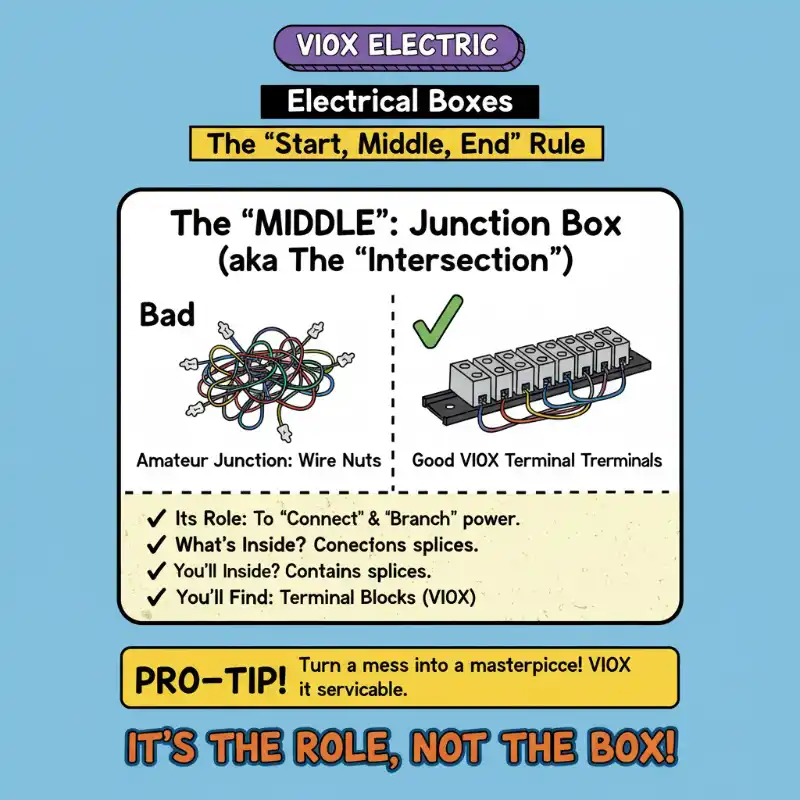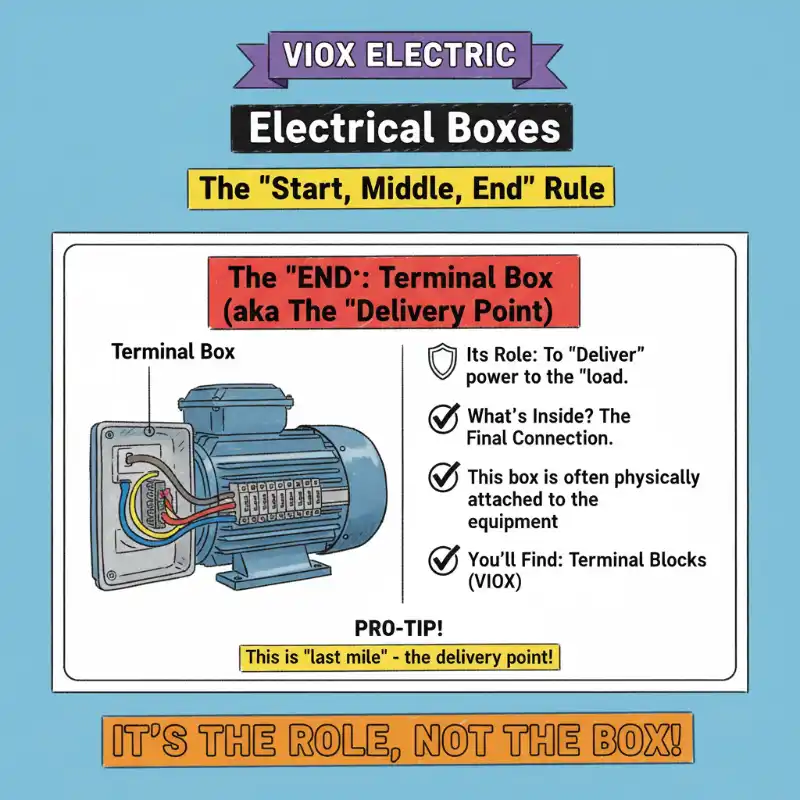Picture this: You walk into an electrical supply store. You walk down the aisle and grab three identical, grey, 4×4-inch metal enclosures.
You put them on the counter. They look exactly the same. They feel the same. They cost the same.
But depending on where you install them tomorrow, one will become a விநியோகப் பெட்டி, one will become a சந்திப்புப் பெட்டி, and one will become a முனையப் பெட்டி.
This is one of the most common sources of confusion for apprentices and even junior engineers. If the hardware is identical, why do we have three different names?
The answer is simple, but profound: An electrical box is defined by its mission, not its material.
A recent discussion among professional electricians perfectly crystallized this definition. It stripped away the jargon and gave us a “Golden Rule” for identifying these boxes instantly.
It’s called the “Start, Middle, End” Rule.
Let’s break down the identity of these three “chameleon” boxes.
1. The “Start” = The Distribution Box (The HQ)
Let’s start at the source.
- The Rule: Distribution = START
- The Alias: Panel Board, Breaker Panel, Load Center, Fuse Box.
- The Mission: To Protect மற்றும் Allocate.
If you take that 4×4 metal box, mount it on the wall where the main utility line enters the building, and stuff it full of சர்க்யூட் பிரேக்கர்கள் or fuses, it has just become a விநியோகப் பெட்டி.
It is the “Headquarters” of your electrical system.
What makes it a Distribution Box?
- உள்ளீடு: It usually takes in one large, heavy-duty feeder cable (the main power).
- செயல்: It splits (distributes) that massive power into smaller, manageable streams (branch circuits).
- பாதுகாப்பு: Crucially, this is where the Overcurrent Protection Devices (OCPDs) live. Every branch circuit leaving this box is guarded by a breaker or fuse.
Pro-Tip: If the box contains devices that trip or blow to save your house from a fire, it is a Distribution Box. It is the start of the circuit.
2. The “Middle” = The Junction Box (The Crossroads)
Now, follow the wire leaving the Distribution Box. It runs through the ceiling, down a hallway, and needs to split off to feed three different office lights.
You cut the conduit. You mount that second 4×4 metal box in the ceiling. You pull the wires in, strip them, twist them together with wire nuts, and slap a blank cover on it.
Congratulations. You just created a சந்திப்புப் பெட்டி.
- The Rule: Junction = MIDDLE
- The Alias: J-Box, Splice Box, Pull Box.
- The Mission: To Connect மற்றும் Branch.
A Junction Box is the “Crossroads” of the electrical highway. It is where wires meet, mingle, and go their separate ways.
What makes it a சந்திப்புப் பெட்டி?
- Content: It contains splices (wire nuts, WAGO connectors, or terminal blocks). It rarely contains active devices like switches or breakers.
- இடம்: It is located between the source (Distribution Box) and the load (the machine or light).
- நோக்கம்: It exists because you can’t run a single continuous wire forever. Eventually, you need to join two wires, split one wire into two, or just change direction.
Pro-Tip: If you open a box and see a “spaghetti bowl” of wires twisted together, but no device doing any “work,” you are looking at a Junction Box. It is the middle of the circuit.
3. The “End” = The Terminal Box (The Handshake)
Finally, the wire leaves the Junction Box and arrives at the machine—let’s say, a large industrial motor or a heater.
You bolt the third 4×4 metal box directly onto the side of the motor. You pull the supply wires in. Inside, you see a neat row of bolts or a block. You bolt your supply wire ring terminals down onto the motor’s leads.
This is the முனையப் பெட்டி.
- The Rule: Terminal = END
- The Alias: Motor Peckerhead (industry slang), T-Box, Connection Box.
- The Mission: To Deliver.
The Terminal Box is the “Handshake.” It is the specific point where the building’s wiring ends and the machine’s internal wiring begins.
What makes it a Terminal Box?
- இடம்: It is almost always mounted on அல்லது inside the load equipment (motor, transformer, heater, instrument).
- Content: It usually contains a முனையத் தொகுதி—a fixed, rigid strip for bolting wires down—rather than floating wire nuts.
- நோக்கம்: It facilitates the final transfer of power to the device doing the work.
Pro-Tip: If the box is vibrating because it’s bolted to a running motor, it is a Terminal Box. It is the end of the circuit.
Summary: The “Start, Middle, End” Cheat Sheet
To recap, don’t look at the metal. Look at the mission. Here is your cheat sheet:
| அம்சம் | விநியோகப் பெட்டி | சந்திப்புப் பெட்டி | முனையப் பெட்டி |
|---|---|---|---|
| விதி | START | MIDDLE | END |
| Primary Job | Protect & Split Power | Join & Branch Wires | Deliver Power to Load |
| Key Component | Breakers / Fuses | Wire Nuts / Splices | முனையத் தொகுதிகள் |
| இடம் | Service Entrance / Utility Room | Ceiling / Wall / Conduit Run | Mounted ON the Equipment |
| Analogy | The Headquarters | The Intersection | The Loading Dock |
Why This Matters for Engineers
You might think, “It’s just semantics.” But using the wrong term gets expensive fast.
- If you order a “Distribution Box” when you need a “Junction Box,” you might receive a large enclosure with DIN rails and busbars you don’t need (and paid extra for).
- If you spec a “Terminal Box” for a wall splice, your installer will be confused looking for the mounting bolts for a motor.
Language is the first tool in an engineer’s kit. Use the “Start, Middle, End” rule, and you’ll never grab the wrong box again.
Technical Accuracy Note
Standards & Sources Referenced: Definitions align with NEC (தேசிய மின் குறியீடு) Article 100 (Definitions) and Article 314 (Boxes and Conduit Bodies).
Context: “Junction Box” and “Pull Box” are often used interchangeably in casual speech, but strictly speaking, a இழு பெட்டி is primarily for aiding in pulling wire, while a சந்திப்புப் பெட்டி is for enclosing splices.
Timeliness: Terminology is current and standard across the electrical industry as of November 2025.






